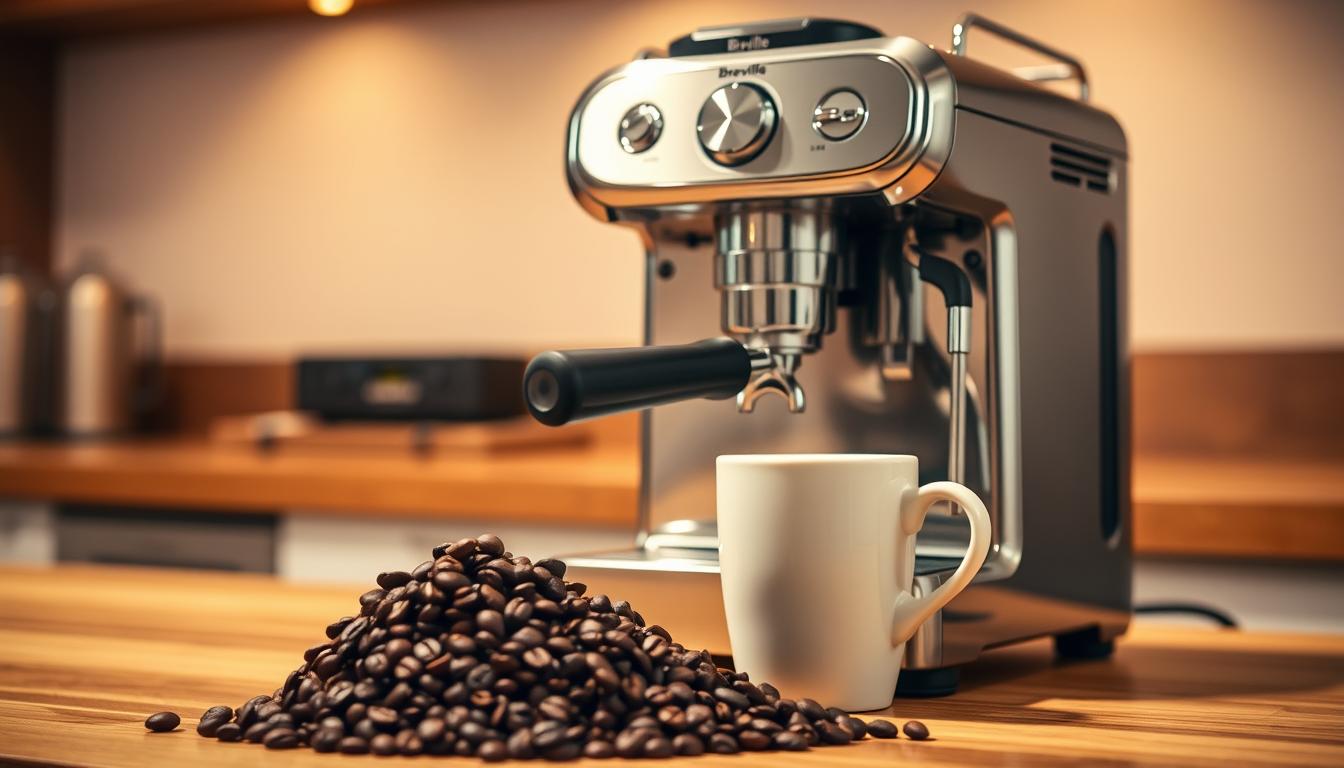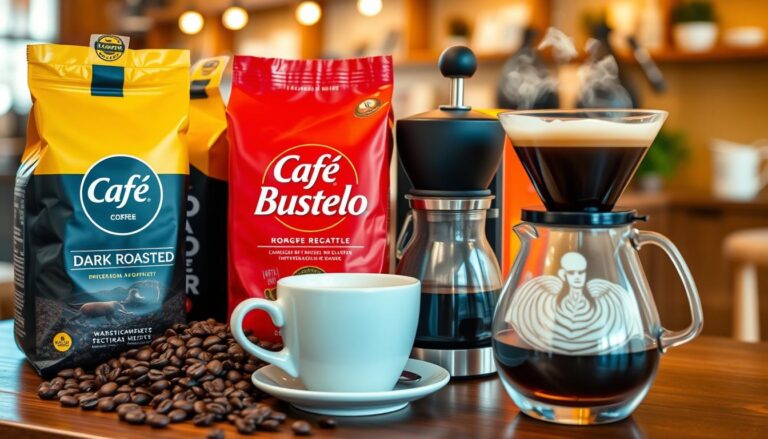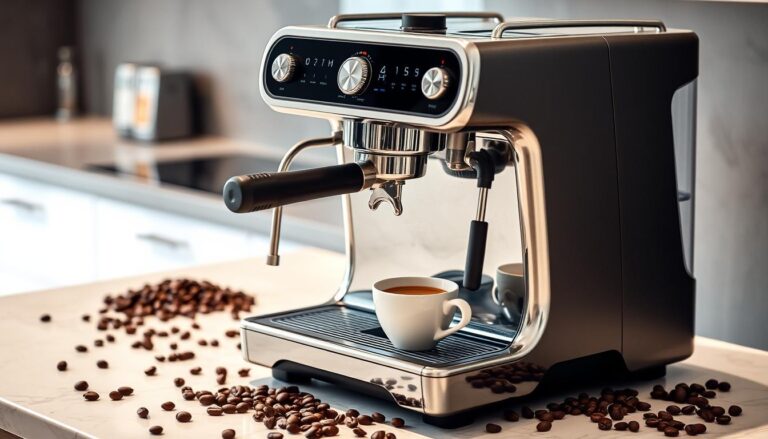Have you ever wondered why a simple machine can make such a big difference in your daily coffee?
When water temperature, fresh beans, and grind size come together just right, your morning starts smoothly. A Breville Espresso Machine makes this happen by giving you precise controls and simple steps to follow.
You’ll learn how keeping the portafilter and grouphead clean keeps your coffee’s flavor pure. You’ll also see how these small details lead to a consistently great espresso. This section shows how Breville opens up a deeper coffee experience for you.
Introduction to Breville Espresso Machines
You’re looking for an espresso machine that’s both reliable and easy to use. Breville is known for making high-quality equipment that makes your coffee time better. With Breville, you can always get a balanced, rich espresso.
Overview of Breville as a Brand
Breville started in Australia and quickly became famous for its quality. You might have seen their products in cafes or homes. They aim to make innovation accessible to everyone, whether you’re new to coffee or a pro.
Key Features of Breville Espresso Machines
The built-in conical burr grinder grinds your coffee in seconds. Clear pressure gauges help you get the perfect shot. The controls are simple, letting you adjust your coffee to your liking. This way, you can make your ideal coffee at home.
Choosing the Right Breville Model for You
Looking at different machines is exciting. Each one has its own special features. Some let you control everything, while others are quick and easy.
Think about how much you want to control the brewing process. The Barista Express has a built-in grinder and adjustable settings for those who like to tweak things. On the other hand, simpler machines have automatic dosing and easy controls. Breville is known for making durable and versatile machines.
Differences Between Popular Breville Models
Some machines have advanced steam wands for better milk texture. Others focus on simplicity. Consider how portable you need it to be, your budget, and how much space you have. Comparing them will help you find the perfect one.
Factors to Consider for Your Brewing Needs
Think about how important milk frothing is to you and how much power you need. Consider how often you’ll make espresso drinks. Decide if you want to customize each shot or prefer a consistent result with just a button.
| Model | Key Feature | Best For |
|---|---|---|
| Barista Express | Built-in Grinder | Hands-on Crafting |
| Barista Pro | Faster Heating | Speed-Focused Users |
| Bambino Plus | Automatic Milk | Easy Latte Creations |
Setting Up Your Breville Espresso Machine
Clear a spot on your kitchen counter for your new espresso machine. Carefully unpack each part and check if everything matches the manual. A quick look at the manual helps you understand where each piece goes.
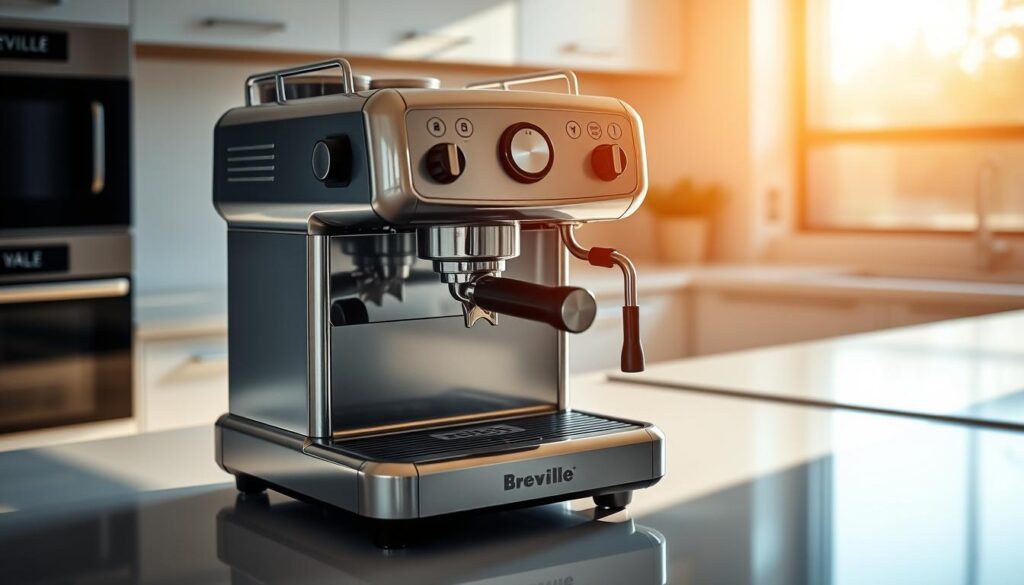
Unboxing Your Machine
First, remove all plastic and cardboard. Place the water tank in position. If your machine has a grinder, lock it in place. Then, attach the portafilter. Start with a simple flush cycle using plain water before making your first brew.
Essential Accessories You Might Need
Having a few extra items can enhance your experience. You’ll want a good tamper and different filter baskets for different coffee strengths. A reliable scale is key for measuring the right amount of coffee grounds. And don’t forget a microfiber cloth to keep things clean.
- Detach and clean removable parts.
- Secure the water filter in place.
- Assemble the portafilter with the right basket.
| Accessory | Purpose |
|---|---|
| Tamper | Compress grounds uniformly |
| Scale | Measure ground coffee accurately |
| Microfiber Cloth | Maintain a clean station |
Coffee Beans
Starting with the right coffee beans gives you richer flavor. Freshness is key to getting the full aroma. Store your coffee beans in an airtight container, away from sunlight.
Choose roasts that match your taste. Whether you like a lighter body or a deeper, smokier note, there’s a roast for you.

Types of Coffee Beans Suitable for Espresso
Arabica beans offer a smooth profile with natural sweetness. Robusta beans add a bolder edge to your shot. Light roasts have bright acidity, while darker roasts have a stronger body.
Make sure to check the roast date. This ensures a thick crema and balanced extraction.
How Bean Quality Affects Taste
Quality beans bring complexity to your coffee. They can have subtle floral notes or full-bodied richness. High-grade beans enhance flavor clarity and mouthfeel.
Try different beans to find the perfect cup. This will lead to the signature Breville espresso you’ve always dreamed of.
Grinding Your Coffee Beans
Breville espresso fans know the right grind is key. The size of the grind affects the taste. A finer grind brings out bold flavors, while a coarser one makes the taste milder.

Choosing the Right Grind Size
Your Breville grinder might have an external dial or an internal ring. Adjust it slowly to find the perfect balance. Try small batches and check how fast the espresso flows.
If it flows too slowly, the grind might be too fine. If it flows too quickly, it’s too coarse.
Importance of Freshly Ground Coffee
Freshly ground coffee keeps its aroma and taste. Grinding just before use brings out the best flavors. Coffee loses its oils and strength if it sits too long.
Keep your grinder clean and store beans in airtight containers. This way, you get the best taste from your coffee.
Measuring and Dosing Coffee
Getting the right amount of ground coffee is key to a great espresso. It affects the texture, aroma, and taste. By measuring carefully, you control the water flow and extraction, keeping your espresso consistent.
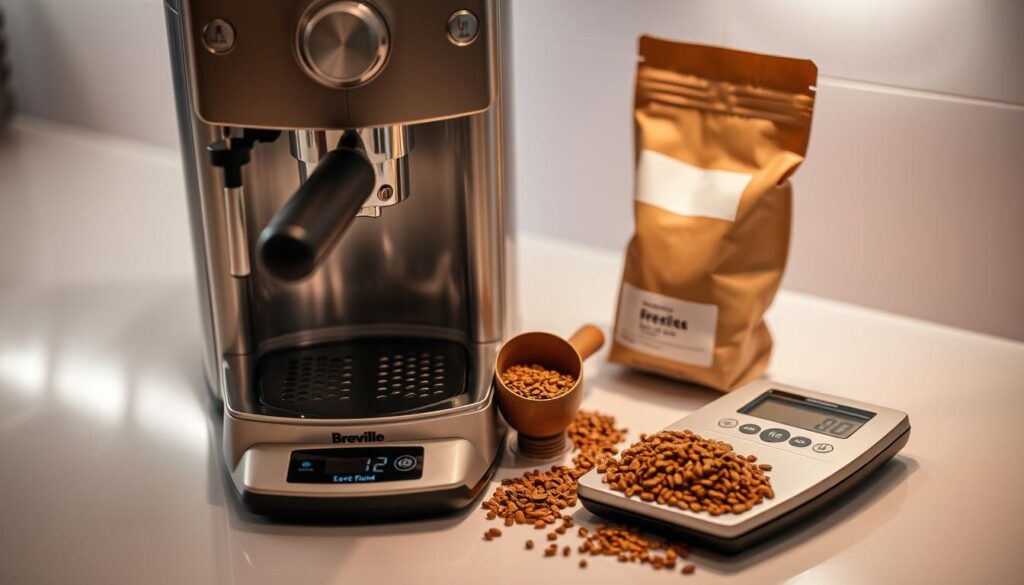
Recommended Coffee-to-Water Ratios
Baristas often start with 18 grams of coffee for a 36 to 40 gram yield in under 30 seconds. This ratio brings out the coffee’s flavors and avoids bitterness. Try small changes to find your ideal ratio.
Tools for Accurate Dosing
A scale is essential for precise measurements. It helps you track small changes in your recipe. You might also use dosing funnels or special scoops for less mess.
A consistent tamper and distribution method are important. They ensure even water contact, making your espresso smoother.
| Ground Coffee | Yield | Time |
|---|---|---|
| 16 g | 32–35 g | 20–25 s |
| 18 g | 36–40 g | 25–30 s |
| 20 g | 40–45 g | 28–32 s |
Preparing Your Breville Espresso Machine
Starting your day with a well-heated device can improve the taste of every espresso shot. Warming the grouphead and portafilter before pulling a shot supports a more stable temperature. This boosts flavor extraction. A few minutes of warm-up can set you on a path to a richer cup.
Preheating the Machine
Flush hot water through the grouphead, then let the portafilter sit under that warm flow. This process primes each component, helping your coffee release balanced aromas. Steady warmth enhances shot quality by maintaining the right temperature from start to finish.
Water Quality and Importance
Filtered water protects your Breville espresso machine from scale buildup. It keeps mineral content low, preserving the true essence of your coffee beans. Tap water with heavy mineral deposits might affect flavor clarity and lead to frequent cleaning sessions.
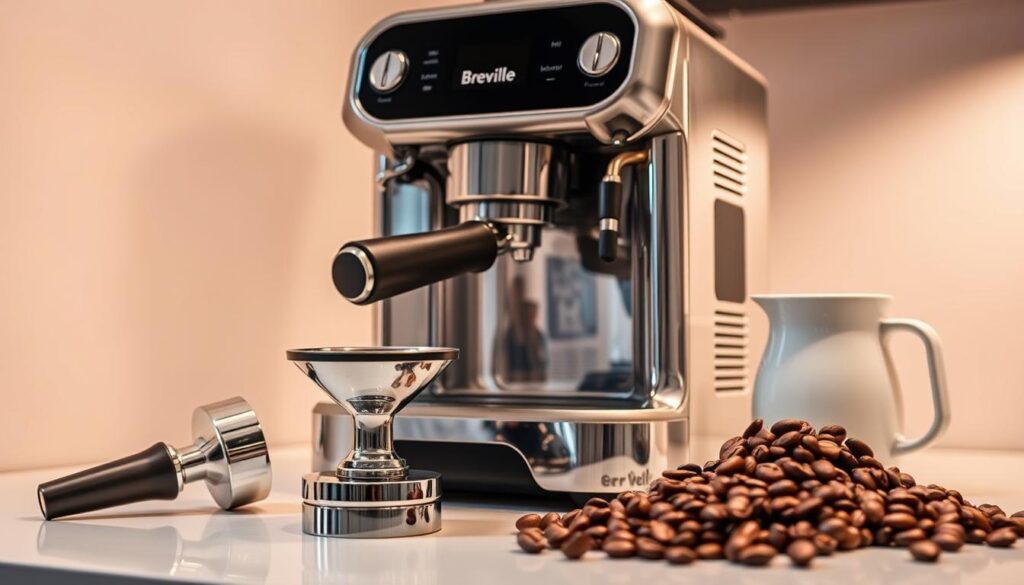
Brewing Your Espresso Shot
Creating fresh espresso needs focus and a ready station. You must have the right timing, grind, and dose for bold flavors. A good brew brings out smooth tastes and a rich crema.
Step-by-Step Brewing Process
First, lock the portafilter into your Breville espresso machine. Choose a single or double shot, depending on what you like. Watch the pressure gauge and aim for 25–30 seconds of extraction.
This time is key for bringing out the flavors in your cup. Adjusting the grind size or tamp pressure can make your espresso velvety.
Tips for Consistent Results
Always keep your basket clean and your beans fresh. Pay attention to changes in taste or crema. These signs tell you when to make adjustments.
Regularly check your machine settings and cleaning routines. This keeps your coffee smooth and rich. Fine-tuning every step makes your coffee experience better.
Steaming and Frothing Milk
Mastering the steam wand is key to a velvety latte or cappuccino. It’s all about keeping a steady angle and using fresh ingredients. This ensures your drink has a consistent texture and a richer taste.
Choosing the Right Milk
Whole milk is a favorite for its natural sweetness and balanced fat. Almond or soy milk offers unique flavors that complement many coffee drinks. Think about what you like and your dietary needs when choosing.
Techniques for Perfect Froth
Begin by releasing steam to clear water from your Breville wand. Hold the tip close to the surface to create small bubbles. This makes microfoam. Swirl the milk gently to heat it evenly.
Feel the jug’s base to check the warmth. Stop frothing when it’s warm but not hot.
Cleaning and Maintenance of Your Machine
Regular care keeps your Breville espresso machine in top shape. It ensures every cup tastes great. Cleaning away residue and preventing buildup keeps performance steady.
Daily Cleaning Routines
Begin with a quick rinse of the portafilter and group head. Run water through to clear out any grounds. After steaming milk, purge the steam wand to remove any residue.
Wipe down removable parts to protect the taste. This makes your machine ready for the next brew.
Seasonal Deep Cleaning Tips
Descaling every few months is key to fight mineral buildup. This keeps water flowing well. Also, replace filters to keep flavors fresh.
For a deep clean, soak parts in a gentle solution. Then, rinse them carefully. This routine ensures your espresso shots stay crisp and enjoyable.
Troubleshooting Common Issues
Brewing espresso can reveal small setbacks that affect flavor and consistency. You might encounter bitter shots, sour notes, or weak extractions. Fine-tuning your grind, tamp, and temperature helps resolve these hurdles, preserving the rich taste in every pull.
Identifying Brewing Problems
Watch for shots that drip too slowly or race through the portafilter. A bitter taste might trace back to over-extraction, while sour flavor often signals under-extraction. Weak coffee results when grounds are too coarse or poorly distributed. Consistent grinds and well-leveled tamping keep each shot balanced.
Solutions for Espresso Machine Issues
Backflush and descale on a schedule to avoid clogs. Clear steam wand blockages by purging it after each frothing session. Confirm that your Breville machine maintains stable heat and pressure. Pay attention to coffee distribution, tamp force, and grind size for uniform extraction.
| Issue | Possible Cause | Effective Fix |
|---|---|---|
| Overly Bitter Shots | Excessive Extraction | Shorten brew time or use a coarser grind |
| Sour Aftertaste | Under-Extraction | Use a finer grind or slightly longer brew cycle |
| Steam Wand Blockages | Dried Milk Residue | Purge wand after each use and soak for deeper cleaning |
Conclusion: Enjoying Your Perfect Brew
You’ve learned how to make a great cup of coffee. Your Breville machine is ready to make a fresh espresso and creamy milk froth. Every cup is a chance to get better and try new coffee beans.
Exploring Coffee Variations
Try making mocha, flat white, or latte with flavored syrups. Use plant-based milks for extra flavor. Add caramel or cinnamon for a special touch.
Sharing Your Espresso Experience
Share your coffee at gatherings or online. Share tips on steaming and coffee types. This builds a community of coffee lovers who learn from each other. You help make café-quality coffee at home.

